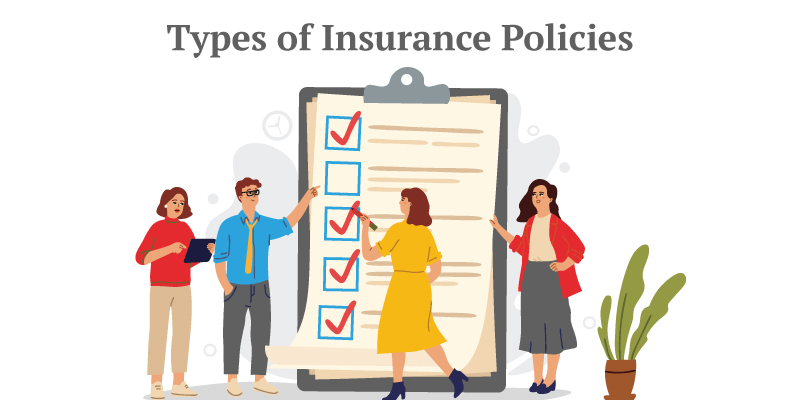Insurance is a financial tool designed to provide protection against potential future losses. It involves a contract between an individual or entity (the policyholder) and an insurance company, where the policyholder pays a premium in exchange for the promise of compensation for specific potential losses or damages. Understanding the different types of insurance policies is crucial for making informed decisions about risk management and financial planning. This article will explore various insurance types, their purposes, and key considerations.
1. Health Insurance
Health insurance is one of the most vital forms of insurance, designed to cover medical expenses. These expenses can include hospital stays, surgeries, doctor visits, prescription drugs, and other healthcare-related costs. There are several types of health insurance plans:
- Health Maintenance Organization (HMO): Requires policyholders to use a network of doctors and hospitals. Primary care physicians play a central role in managing care.
- Preferred Provider Organization (PPO): Offers more flexibility in choosing healthcare providers. Policyholders can see specialists without referrals.
- Exclusive Provider Organization (EPO): Combines features of HMOs and PPOs, offering network restrictions but allowing direct access to specialists.
- Point of Service (POS): Blends HMO and PPO features, requiring referrals for specialists but providing some out-of-network coverage.
Health insurance plans can vary significantly in terms of premiums, deductibles, copayments, and coverage limits. Choosing the right plan involves balancing these factors based on individual health needs and financial capabilities.
2. Life Insurance
Life insurance provides financial protection to beneficiaries in the event of the policyholder’s death. It ensures that loved ones are financially secure after a loss. There are two primary types of life insurance:
- Term Life Insurance: Provides coverage for a specified term, such as 10, 20, or 30 years. It offers a death benefit but does not accumulate cash value. It is generally more affordable and straightforward.
- Permanent Life Insurance: Includes whole life, universal life, and variable life policies. These provide lifelong coverage and have a cash value component that grows over time. Permanent life insurance is more expensive but offers investment opportunities and potential loans against the policy’s cash value.
The choice between term and permanent life insurance depends on individual financial goals, such as income replacement, debt coverage, or estate planning.
3. Auto Insurance
Auto insurance protects against financial loss from accidents, theft, and other vehicle-related incidents. Most states require a minimum level of auto insurance. Key components of auto insurance include:
- Liability Coverage: Pays for damages and injuries to others if the policyholder is at fault in an accident.
- Collision Coverage: Covers damage to the policyholder’s vehicle from collisions, regardless of fault.
- Comprehensive Coverage: Protects against non-collision-related damages, such as theft, vandalism, natural disasters, and animal strikes.
- Personal Injury Protection (PIP): Covers medical expenses and lost wages for the policyholder and passengers, regardless of fault.
- Uninsured/Underinsured Motorist Coverage: Protects against accidents involving drivers without adequate insurance.
Understanding state requirements and personal driving habits can help in selecting the appropriate auto insurance coverage.
4. Homeowners Insurance
Homeowners insurance provides financial protection for homes and personal property against various risks, including fire, theft, vandalism, and natural disasters. Standard homeowners insurance policies typically include:
- Dwelling Coverage: Covers the physical structure of the home.
- Personal Property Coverage: Protects personal belongings inside the home.
- Liability Protection: Covers legal expenses if someone is injured on the property.
- Additional Living Expenses (ALE): Pays for temporary housing if the home becomes uninhabitable due to a covered event.
Homeowners should assess the replacement cost of their home and belongings to ensure adequate coverage.
5. Renters Insurance
Renters insurance is designed for those who rent their living space. It provides similar coverage to homeowners insurance but does not include dwelling coverage. Key components of renters insurance include:
- Personal Property Coverage: Protects personal belongings against theft, fire, and other covered perils.
- Liability Protection: Covers legal expenses if someone is injured in the rented space.
- Additional Living Expenses (ALE): Pays for temporary housing if the rental becomes uninhabitable.
Renters insurance is typically affordable and essential for protecting personal assets.
6. Disability Insurance
Disability insurance provides income replacement if a policyholder becomes unable to work due to illness or injury. There are two main types of disability insurance:
- Short-Term Disability (STD): Provides coverage for a short period, typically 3-6 months.
- Long-Term Disability (LTD): Offers coverage for extended periods, potentially until retirement age.
Disability insurance is crucial for maintaining financial stability in the event of a disabling condition.
7. Travel Insurance
Travel insurance covers unexpected events that may occur during travel, such as trip cancellations, medical emergencies, lost luggage, and travel delays. Key components of travel insurance include:
- Trip Cancellation/Interruption Coverage: Reimburses non-refundable travel expenses if a trip is canceled or interrupted due to covered reasons.
- Medical Coverage: Provides coverage for medical emergencies while traveling.
- Evacuation Coverage: Covers costs associated with emergency medical evacuations.
- Baggage Coverage: Protects against loss, theft, or damage to luggage and personal belongings.
Travel insurance is particularly important for international travel and trips with significant prepaid expenses.
8. Business Insurance
Business insurance protects businesses from financial losses due to various risks, such as property damage, liability, and employee-related issues. Common types of business insurance include:
- General Liability Insurance: Covers legal expenses and damages if the business is sued for causing injury or property damage.
- Property Insurance: Protects business property, including buildings and equipment, against damage or loss.
- Workers’ Compensation Insurance: Provides coverage for medical expenses and lost wages for employees injured on the job.
- Professional Liability Insurance: Covers claims related to professional errors or negligence.
- Business Interruption Insurance: Compensates for lost income if the business is temporarily unable to operate due to a covered event.
Businesses should assess their specific risks and industry requirements to determine appropriate coverage.
9. Umbrella Insurance
Umbrella insurance provides additional liability coverage beyond the limits of other insurance policies, such as auto, home, and renters insurance. It is designed to protect against major claims and lawsuits, offering higher coverage limits and broader protection. Umbrella insurance is beneficial for individuals with significant assets or high-risk activities.
Conclusion
Understanding different types of insurance policies is essential for effective risk management and financial planning. Each type of insurance serves a specific purpose and offers unique benefits, tailored to different aspects of life and business. By carefully evaluating individual needs and potential risks, policyholders can select the right insurance coverage to ensure financial protection and peace of mind.





